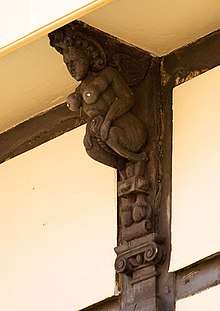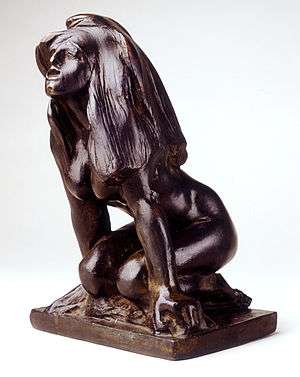Succubus
A succubus is a demon or supernatural entity in folklore, in female form, that appears in dreams to seduce men, usually through sexual activity. According to religious traditions, repeated sexual activity with a succubus can cause poor physical or mental health, even death.


In modern representations, a succubus is often depicted as a beautiful seductress or enchantress, rather than as demonic or frightening.
The male counterpart to the succubus is the incubus.
Etymology
The word is derived from Late Latin succuba "paramour"; from succubare "to lie beneath" (sub- "under" and cubare "to lie"),[1] used to describe this female supernatural being's implied sexual position relative to the male sleeper's position. The word succubus originates from the late 14th century.[2]
In folklore
As depicted in the Jewish mystical work Zohar and the medieval rabbinical text Alphabet of Ben Sira, Lilith was Adam's first wife, who later became a succubus.[3] She left Adam and refused to return to the Garden of Eden after she mated with the archangel Samael.[4] In Zoharistic Kabbalah, there were four succubi who mated with the archangel Samael. There were four original queens of the demons: Lilith, Eisheth, Agrat bat Mahlat, and Naamah.[5] A succubus may take a form of a beautiful young girl but closer inspection may reveal deformities of her body, such as bird-like claws or serpentine tails.[6] Folklore also describes the act of sexually penetrating a succubus as akin to entering a cavern of ice, and there are reports of succubi forcing men to perform cunnilingus on their vulvas, which drip with urine and other fluids.[7] In later folklore, a succubus took the form of a siren.
Throughout history, priests and rabbis, including Hanina Ben Dosa and Abaye, tried to curb the power of succubi over humans.[8] However, not all succubi were malevolent. According to Walter Map in the satire De Nugis Curialium (Trifles of Courtiers), Pope Sylvester II (999–1003) was allegedly involved with a succubus named Meridiana, who helped him achieve his high rank in the Catholic Church. Before his death, he confessed of his sins and died repentant.[9]
Ability to reproduce
According to the Kabbalah and the school of Rashba, the original three queens of the demons, Agrat Bat Mahlat, Naamah, Eisheth Zenunim, and all their cohorts give birth to children, except Lilith.[10] According to other legends, the children of Lilith are called Lilin.
According to the Malleus Maleficarum, or "Witches' Hammer", written by Heinrich Kramer (Institoris) in 1486, succubi collect semen from men they seduce. Incubi, or male demons, then use the semen to impregnate human females,[11] thus explaining how demons could apparently sire children despite the traditional belief that they were incapable of reproduction. Children so begotten—cambions—were supposed to be those that were born deformed, or more susceptible to supernatural influences.[12] While the book does not address why a human female impregnated with the semen of a human male would not produce regular human offspring, an explanation could be that the semen is altered before being transferred to the female host. However in some lore, the child is born deformed because the conception was unnatural.
King James in his dissertation titled Dæmonologie refutes the possibility for angelic entities to reproduce and instead offered a suggestion that a devil would carry out two methods of impregnating women: the first, to steal the sperm out of a dead man and deliver it into a woman. If a demon could extract the semen quickly, the substance could not be instantly transported to a female host, causing it to go cold. This explains his view that succubi and incubi were the same demonic entity only to be described differently based on the tormented sexes being conversed with. The second method was the idea that a dead body could be possessed by a devil, causing it to rise and have sexual relations with others. However, there is no mention of a female corpse being possessed to elicit sex from men.[13]
Qarinah
In Arabian mythology, the qarînah (قرينة) is a spirit similar to the succubus, with origins possibly in ancient Egyptian religion or in the animistic beliefs of pre-Islamic Arabia.[14] A qarînah "sleeps with the person and has relations during sleep as is known by the dreams".[15] They are said to be invisible, but a person with "second sight" can see them, often in the form of a cat, dog, or other household pet.[14] "In Omdurman it is a spirit which possesses. ... Only certain people are possessed and such people cannot marry or the qarina will harm them."[16] To date, many African myths claim that men who have similar experience with such principality (succubus) in dreams (usually in form of a beautiful woman) find themselves exhausted as soon as they awaken; often claiming spiritual attack upon them. Local rituals/divination are often invoked in order to appeal the god for divine protection and intervention.
Scientific explanations
In the field of medicine, there is some belief that the stories relating to encounters with succubi bear resemblance to the contemporary phenomenon of people reporting alien abductions,[17] which has been ascribed to the condition known as sleep paralysis. It is therefore suggested that historical accounts of people experiencing encounters with succubi may rather have been symptoms of sleep paralysis, with the hallucination of the said creatures coming from their contemporary culture. Furthermore, the experience of nocturnal emissions or "wet dreams" may explain the sexual aspect of the phenomenon.[18][19]
In fiction
Throughout history, succubi have been popular characters in music, literature, film, television, and more.
See also
- Similar creatures in folklore
- Al Basti
- Baobhan Sith
- Empusa
- Fox spirit
- Hisa-me
- Hone-onna
- Huldra
- Jorōgumo
- Lamia (Basque mythology)
- Leanan sídhe
- Lidérc
- Mare (folklore)
- Mavka
- Moura Encantada
- Sayona
- Sihuanaba
- Patasola
- Samodiva
- Trauco
- Tunda
- Xana
- Xtabay
- Siren
References
- "Succuba". dictionary.com.
- Harper, Douglas. "Succubus". Online Etymology Dictionary.
- "The Story Of Lilith". jewishchristianlit.com. Retrieved 21 September 2016.
- "Samael & Lilith". istina.rin.ru. Retrieved 21 September 2016.
- "Zohar: Chapter XXXII".
- Davidson, Jane P. (2012). Early modern supernatural : the dark side of European culture, 1400-1700. Santa Barbara, Calif.: Praeger. p. 40. ISBN 9780313393433.
- Guiley, Rosemary Ellen (2008). The encyclopedia of witches, witchcraft and wicca (3rd ed.). New York: Facts On File. p. 95. ISBN 9781438126845.
- Geoffrey W. Dennis, The encyclopedia of Jewish myth, magic and mysticism. p. 126
- History of the Succubus
- Alan Humm. "Kabbala: Lilith, Queen of the Demons". lilithgallery.com. Retrieved 21 September 2016.
- Kramer, Heinrich and Sprenger, James (1486), Summers, Montague (translator – 1928), The Malleus Maleficarum, Part2, Chapter VIII, "Certain Remedies prescribed against those Dark and Horrid Harms with which Devils may Afflict Men," at sacred-texts.com
- Lewis, James R., Oliver, Evelyn Dorothy, Sisung Kelle S. (Editor) (1996), Angels A to Z, Entry: Incubi and Succubi, pp. 218, 219, Visible Ink Press, ISBN 0-7876-0652-9
- Warren, Brett (2016). The Annotated Dæmonologie of King James. A Critical Edition. In Modern English. pp. 79–83. ISBN 978-1-5329-6891-4.
- Zwemer, Samuel M. (1939). "5". Studies in Popular Islam: Collection of Papers dealing with the Superstitions and Beliefs of the Common People. London: Sheldon Press.
- Tremearne, A. J. N. Ban of the Bori: Demons and Demon-Dancing in West and North Africa.
- Trimingham, J. Spencer (1965). Islam in the Sudan. London: Frank Cass & Co. Ltd. p. 172.
- Knight-Jadczyk, Laura; Henri Sy (2005). The high strangeness of dimensions, densities, and the process of alien abduction. Red Pill Press. p. 92. ISBN 9781897244111.
- "Sleep Paralysis". The Skeptics Dictionary.
- "Phenomena of Awareness during Sleep Paralysis". Trionic Research Institute.
External links
| Look up succubus in Wiktionary, the free dictionary. |
| Wikimedia Commons has media related to Succubus. |
- "The Wiki of the Succubi - SuccuWiki". www.succubus.net. Retrieved 6 November 2016.